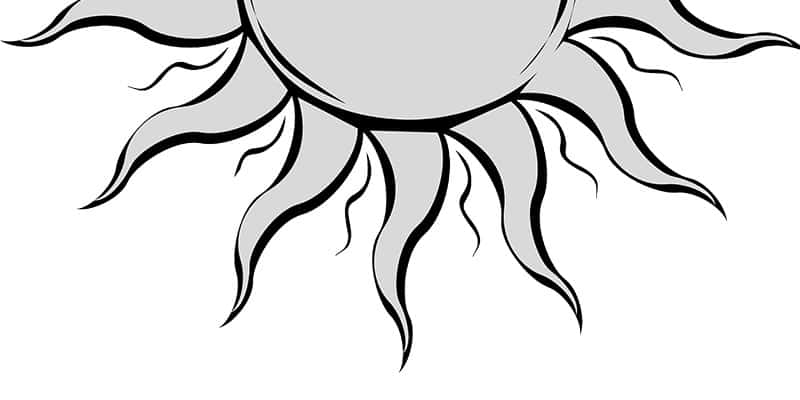The cleric Domain of Light is a fiery defender in Dungeons and Dragons 5e, complete with burning spells and projections of light. Sure, this is a classic fantasy character, but I’m thinking a warforged zombie terminator could really spice this build up. Not only can we make a fierce, fiery tank, we could explore the fun contrast between a machine and spiritual wisdom in role play. He’s obnoxiously polite and super effective at smiting the undead.
Build a warforged cleric Domain of Light in DnD 5e as a zombie terminator:
- Lean into Warforged traits for Defense
- Build a basic cleric with high AC, shield and mace
- Utilize fiery Domain of Light abilities and spells against enemies
- Choose utility spells to compliment fire and light magic
As added flavor to the character, I’ll give him glowing white eyes and a sunny disposition. However, in the face of the undead, his eyes turn red. It’s time to terminate.
Lean into Warforged traits for Defense
Warforged are essentially fantasy robots—automatons or golems of metal, wood and magic. I’ll gain +2 Constitution, plus an additional +1 to another ability of my choice. Naturally, the cleric class demands I choose a +1 Wisdom modifier for my cleric spells.
Constructed Resilience grants this character several benefits:
- Advantage on saving throws against being poisoned. Plus, resistance to poison damage.
- I don’t need to eat, drink, sleep or breath
- Immunity to disease—Who’s worried about those dirty old crypts anyway?
Sentry’s Rest is my version of a long rest, where I essentially “turn off” for 6 hours and remain in a motionless state. I’ll appear inert, but still won’t be asleep. In other words, I’m still conscious, just resting my parts.
Integrated Protection gives my character +1 AC. Plus, I integrate my armor into my body—as in upgrades to my exoskeleton. I must spend an hour integrating the armor layer, but it can’t be taken off me after I do so. I like how my core “tank” options work in conjunction with this race—so my class spells can offer offensive firepower. Spoilers, it will.
Finally, Specialized Design grants me bonus proficiencies in 1 skill of my choice and 1 tool set. I’ll choose something useful, like History, Religion or Arcana for my bonus skill proficiency. However, Thieves’ tools could be an off-the-wall proficiency that still fits thematically—he wants to disarm traps and has the build to tank trap effects like poison or explosions.
Build a basic cleric with high AC, shield and mace
Clerics work best with high Wisdom and Constitution, so those 2 skills should be the highest—even with the bonuses offered by the warforged race. I’m much more of a fan of hyper specializing than making a well-rounded character.
As a defender of my allies, I’ll be sure to integrate medium armor (14 or 15 AC) and a shield (+2 AC). Along with my +1 bonus from Integrated Protection, I’m looking at an AC of 17 or 18. I’ll keep my shield armed most of the time, switching between magic and a mace (1d6 bludgeoning) in the other hand. However, I’ll lean into my high-damage spells more often than not.
Related Posts:
Guide to Playing a Mountain Dwarf
| Zombie Apocalypse Guide: DnD 5e/Pathfinder
|
For my 2 proficient skills, I’ll choose History and Medicine. Sure, this cleric is a zombie-clearing weapon, but he’s still a cleric. Medicine will give this character the soft side he needs as a servant of the Light. History will give me investigative help. Maybe it can come in handy in zombie research.
By level 2, I’ll learn Channel Divinity, which allows me to channel divine energy into a relic. This divine energy has several effects, depending on my Domain. However, all clerics can Turn Undead with this energy. Undead enemies within 30 feet of the channeled energy must make a Wisdom saving throw. On a fail, they flee. This ability changes to Destroy Undead at level 5, with the ability to destroy stronger undead creatures at higher levels.
Finally, all clerics gain Divine Intervention at level 10. As an action, I can roll percentile dice to attempt this intervention. If I roll a number equal to or lower than my cleric level, my deity intervenes in some way. This intervention is at the discretion of the DM.
Utilize fiery Domain of Light abilities and spells against enemies
Clerics of the Light Domain begin with the bonus cantrip light, covering ordinary objects in a cloak of radiant light.
Light Domain clerics also gain the Warding Flare ability at level 1, blinding enemies with a flash of light to give them disadvantage on attack rolls against me. I’ll be able to use this ability an amount of times per day equal to my Wisdom modifier. Along with my enhanced armor class, this light flare adds even more defensive capability to my unstoppable zombie-killing machine.
My special Channel Divinity effect is called Radiance of the Dawn, blasting enemies with fire and eliminating darkness. The range for this light burst is 30 feet, forcing any enemy in range to make a Constitution saving throw. On a failed save, the enemy takes 2d10 + Cleric level fire damage. On a successful save, the enemy takes half as much damage.
Improved Flare (level 6) gives me the ability to use Warding Flare when an ally is attacked. Therefore, I can potentially save friends from enemy attacks by blasting light around the field like a disco ball.
Potent Spellcasting (level 8) gives extra damage to my cleric cantrips equal to my Wisdom modifier.
Finally, Corona of Light (level 17) gives me an ultimate halo of light, giving disadvantage to saving throws against my fire and light spells. The range for this spell is 60 feet, casting 30 feet of dim light beyond that.
Light Domain Spells
My special list of Light Domain spells is reminiscent of the sun—full of fire and light. This list gives me options to light the way for my allies and go nuclear on my enemies.
Level 1
- Burning hands: Shoot a 15-foot cone of fire for 3d6 damage. Target must make Dexterity saving throw. On success, they take half damage.
- Faerie fire: Illuminates everything within a 20-foot cube. Any creature falling under this light loses the benefit of invisibility, and players have advantage against them on attack rolls.
3
- Flaming sphere: Create a 5-foot fire sphere. Any creature that begins or ends their turn within 5 feet of the sphere takes 2d6 damage. I can then move the sphere 30 feet around the field as a bonus action.
- Scorching ray: Blast 3 rays from my hand, each dealing 2d6 fire damage. I can make a ranged spell attack against one foe or separate foes for each ray created.
5
- Daylight: Create a 60-foot-radius sphere of light, shedding additional dim light for an extra 60 feet. I can cast this on a moving object and the light will move with it.
- Fireball: Shoot a fire blast that explodes in a 20-foot-radius sphere. Each creature in range must make a Dexterity saving throw or take 8d6 damage. As usual, creature who succeed the Dexterity check take half as much damage (4d6).
7
- Guardian of faith: A spectral guardian with glowing shield and sword stands in an unoccupied space of my choice. When enemies move within 10 feet, they take 20 points of radiant damage on a failed Dexterity save. It will disappear if enemies deal 60 damage to it. This is huge at level 7.
- Wall of fire: Either make a 60-foot-long wall of fire or 20-foot diameter. Creatures in range of the wall must make a Dexterity save or take 5d8 fire damage. Any creature that ends its turn within 10 feet of the opposite side of the wall must make this save or take damage.
9
- Flame strike: A 40-foot-tall pillar of flame with a 10-foot radius strikes down on enemies. Enemies make a Dexterity save or take 4d6 fire damage and 4d6 radiant damage. Take note that this can hit flying enemies.
- Scrying: Allows me to find a particular creature that is on the same plane as me. This depends on how well I know my target, so that I can’t just find goals magically. My knowledge of the target affects their ability to resist the spell.
Choose utility spells to compliment fire and light magic
As a cleric, I’ll have my basic set of spells and cantrips to choose from. Obviously, my class offers some dangerous spell options. Therefore, I’ll consider utility spells in these slots to do my cleric thing. I’ll still want to heal and protect my allies as a good cleric would. Also, I should remember to choose Sacred Flame for my Potent Spellcasting ability.
Related Posts:
Best Grimdark Fantasy Movies and TV
| Guide to Building a Steampunk Campaign: DnD 5e
|
Cantrips
- Sacred flame: On a failed Dexterity save, target takes 1d8 fire damage. Target gets no benefit from cover.
- Spare the dying: Immediately stabilize a target with 0 HP.
- Guidance: Touch a willing creature. This creature gains an extra 1d4 to skill checks until the spell ends (1 minute).
1st-level spells
- Cure wounds: A creature I touch regains 1d8 + my Wisdom modifier HP. Upgrades to 2d8 at 2nd-level slot.
- Detect Good and Evil: This one is self-explanatory. I’ll need the ability to track my targets for annihilation.
- Detect Magic: I’ll be able to find a source of magic and sense what type of magic is being emanated. Again, I’m playing off the detection elements of a robot.
- Protection from Evil and Good: Grant protection to target within reach. Aberrations, celestials, elementals, fey, fiends and undead have disadvantage on attacking target. Also, target cannot be charmed, frightened or possessed by one of these creatures.
2nd-level spells
- Lesser restoration: Heal target of blindness, deafness, paralysis or poison. I like the idea of being the party’s healer, even with a magical furnace of fire spells.
- Find traps: Search out traps before they spring on allies. Once again, the robo-detector is at work.






